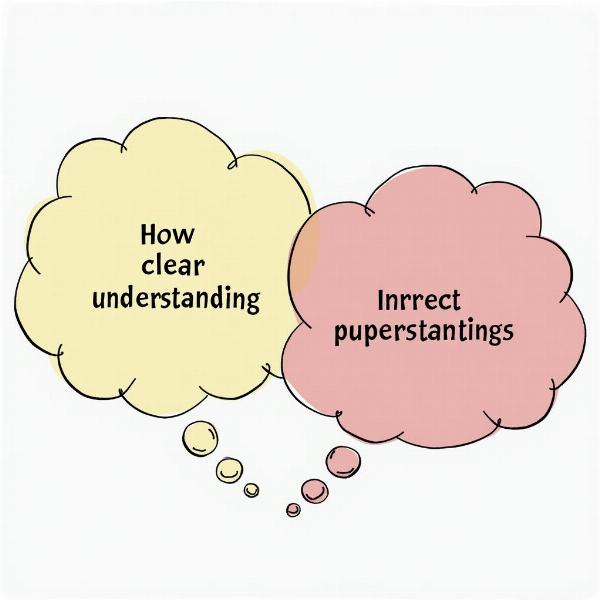Understanding the meaning of “misapprehension” in Hindi is crucial for clear communication and avoiding misunderstandings. This article delves into the various Hindi translations of misapprehension, exploring their nuances and providing practical examples to ensure you grasp the concept completely. We’ll also look at common situations where misapprehensions arise and how to avoid them.
Understanding “Misapprehension”
“Misapprehension” refers to a misunderstanding or a wrong idea about something. It implies a lack of correct understanding or an inaccurate interpretation. In everyday conversations, misapprehensions can lead to confusion, frustration, and even conflict. Knowing the appropriate Hindi equivalents is essential for effective communication, especially in a multicultural context like India.
 Difference Between Misapprehension and Delusion
Difference Between Misapprehension and Delusion
Common Hindi Translations of “Misapprehension”
Several Hindi words effectively capture the essence of “misapprehension.” Some of the most common include:
-
ग़लतफ़हमी (galatfahmi): This is perhaps the most direct and widely used translation. It combines “galat” (wrong) and “fahmi” (understanding), literally meaning “wrong understanding.”
-
भ्रम (bhram): This word carries a slightly different connotation, suggesting a delusion or illusion. While it can be used for misapprehension, it often implies a more deeply rooted misunderstanding, sometimes even bordering on a false belief. See our article on bhram meaning in hindi for more details.
-
ग़लत धारणा (galat dharana): This phrase translates to “wrong notion” or “wrong assumption.” It’s suitable when the misapprehension is based on an incorrect premise or preconceived idea.
-
भ्रांति (bhranti): Similar to “bhram,” this word implies a misconception or mistaken belief, often arising from faulty perception or incomplete information.
-
कुधारणा (kudharana): This term refers to a false notion, typically based on ignorance or prejudice. It’s less common than “galatfahmi” but can be used in specific contexts.
How to Use These Translations in Context
Choosing the right Hindi word for “misapprehension” depends on the specific context. Consider these examples:
-
“There’s a misapprehension about my intentions.” This could be translated as “मेरे इरादों के बारे में एक ग़लतफ़हमी है (mere iradon ke bare mein ek galatfahmi hai).”
-
“He was under the misapprehension that he was invited.” This might be translated as “उसे यह भ्रम था कि उसे आमंत्रित किया गया था (use yah bhram tha ki use aamantit kiya gaya tha).” This example leans towards “bhram” because it involves a false belief.
-
“She had a misapprehension about the company’s policies.” This could be expressed as “उसे कंपनी की नीतियों के बारे में ग़लत धारणा थी (use company ki neetiyon ke bare mein galat dharana thi).” This uses “galat dharana” because it refers to an incorrect notion.
Avoiding Misapprehensions
Clear and precise communication is key to avoiding misapprehensions. Active listening, asking clarifying questions, and ensuring your message is unambiguous can significantly reduce the likelihood of misunderstandings. Furthermore, being aware of cultural differences and nuances in language can further enhance effective communication. You may find our article on waham meaning in hindi helpful in understanding related concepts.
Conclusion
Understanding “misapprehension meaning in hindi” is vital for effective communication. By utilizing the appropriate Hindi translation – be it “galatfahmi,” “bhram,” or other related terms – you can avoid misunderstandings and foster stronger relationships. Remember, clarity and context are key to choosing the right word and ensuring your message is accurately conveyed.
FAQ
-
What is the most common Hindi word for “misapprehension”? Galatfahmi is the most common and direct translation.
-
When should I use “bhram” instead of “galatfahmi”? Use “bhram” when the misunderstanding is more deeply rooted or resembles a false belief. You might also want to explore the meaning of delusional in hindi for further insight.
-
How can I avoid misapprehensions? Clear communication, active listening, and asking clarifying questions are crucial.
-
Is there a difference between “galat dharana” and “galatfahmi”? While both refer to misunderstanding, “galat dharana” specifically points to an incorrect notion or assumption. Consider the nuances explored in our article on misbelief meaning in hindi.
-
What does “kudharana” mean? “Kudharana” refers to a false notion often based on ignorance or prejudice.
Related Articles
You might also be interested in reading about bharm meaning in hindi.
Meaning-Hindi.in is your trusted partner for professional Hindi translation services. We specialize in business, legal, technical, website, educational, and specialized translations, offering quick turnaround times and accurate results. Our expertise in these areas ensures that your message is conveyed with precision and cultural sensitivity. Need help with your Hindi translation projects? Contact us today! Email: [email protected], Phone: +91 11-4502-7584. Meaning-Hindi.in is here to help bridge the language gap.